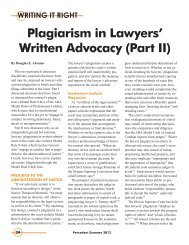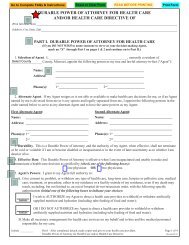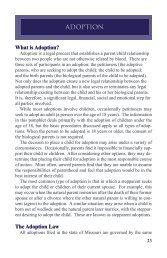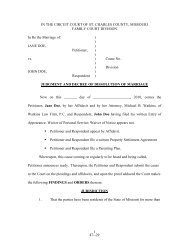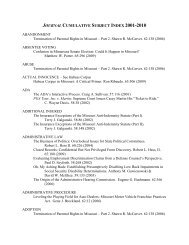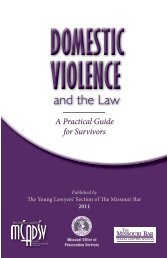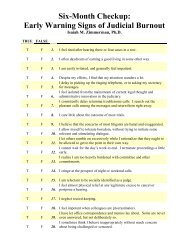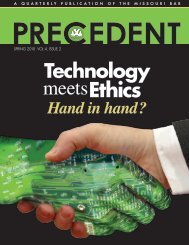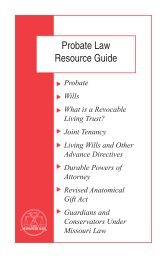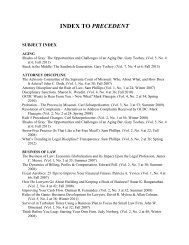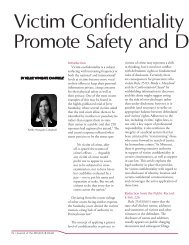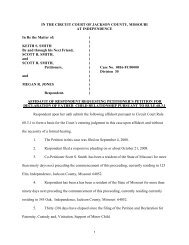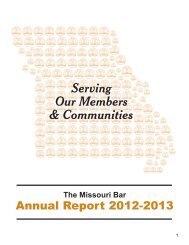New Trust Account Rules Effective July 1, 2013 ... - the Missouri Bar
New Trust Account Rules Effective July 1, 2013 ... - the Missouri Bar
New Trust Account Rules Effective July 1, 2013 ... - the Missouri Bar
Create successful ePaper yourself
Turn your PDF publications into a flip-book with our unique Google optimized e-Paper software.
ETHICS<br />
<strong>New</strong> <strong>Trust</strong> <strong>Account</strong> <strong>Rules</strong><br />
<strong>Effective</strong> <strong>July</strong> 1, <strong>2013</strong>:<br />
What You Need to Know<br />
By Melinda J. Bentley<br />
INTRODUCTION<br />
For years, we all have known that <strong>the</strong> safekeeping<br />
property duties are set forth in Rule 4-1.15, but have you<br />
ever tried to find a specific provision in that Rule? That<br />
Rule contains not just those specific duties, but record<br />
keeping requirements, definitions, client file retention rules,<br />
and much more.<br />
<strong>Effective</strong> <strong>July</strong> 1, <strong>2013</strong>, this Rule will be broken down<br />
into four separate rules that take a more organized approach<br />
to finding <strong>the</strong>se specific requirements, as well as noting<br />
responsibilities that come with <strong>the</strong> era of more electronic<br />
banking. But be aware that with this new organizational<br />
system will also come some new duties. This article will<br />
provide you with an overview of <strong>the</strong>se new requirements,<br />
and direct you to resources to help you transition to <strong>the</strong>se<br />
new <strong>Rules</strong>.<br />
NEW ORGANIZATIONAL SYSTEM<br />
The new <strong>Rules</strong> may be found on <strong>the</strong> Supreme Court of<br />
<strong>Missouri</strong>’s website in an order dated October 30, 2012. 1<br />
You should first understand how <strong>the</strong> new <strong>Rules</strong> are<br />
generally organized:<br />
• Rule 4-1.145 – contains definitions for safekeeping<br />
property and IOLTA accounts;<br />
• Rule 4-1.15 – covers <strong>the</strong> duty provisions for <strong>the</strong><br />
safekeeping of property;<br />
• Rule 4-1.155 – includes <strong>the</strong> provisions for<br />
maintaining IOLTA accounts; and<br />
• Rule 4-1.22 – outlines <strong>the</strong> duties for retention of<br />
client files.<br />
Due to <strong>the</strong> length of <strong>the</strong>se <strong>Rules</strong>, this article will focus<br />
primarily on <strong>the</strong> provisions of new Rule 4-1.15, though<br />
highlights of each new rule will be given.<br />
RULE 4-1.145 – DEFINITIONS: THE HIGHLIGHTS<br />
The definitions governing trust accounts remain<br />
largely unchanged, but since we have <strong>the</strong> opportunity to<br />
review <strong>the</strong>se new rules, it is always good to refresh our<br />
recollections about some of <strong>the</strong> primary definitions.<br />
First, what is a “client trust account?” According to<br />
new Rule 4-1.145(a)(3), it is “an account denominated as<br />
such or by words of similar import in which a lawyer or<br />
law firm holds funds on behalf of a client or third person<br />
and on which withdrawals or transfers can be made on<br />
demand, subject only to any notice period that <strong>the</strong> financial<br />
institution is required to observe by law or regulation.<br />
Every client trust account shall be ei<strong>the</strong>r an IOLTA account,<br />
a non-IOLTA trust account, or an exempt trust account.”<br />
Second, what is an “IOLTA account?” According to new<br />
Rule 4-1.145(a)(9), it is “a pooled client trust account held<br />
at an eligible and approved institution that is comprised<br />
of client and third person funds that cannot o<strong>the</strong>rwise earn<br />
income for <strong>the</strong> client or third person in excess of <strong>the</strong> costs<br />
incurred for such income….” The definition goes on to<br />
include <strong>the</strong> types of approved accounts that can be IOLTA<br />
accounts.<br />
Finally, what is a “non-IOLTA account?” According to<br />
new Rule 4-1.145(a)(11), it is ei<strong>the</strong>r “(a) a separate client<br />
trust account for <strong>the</strong> deposit of <strong>the</strong> funds of a particular<br />
client or third person, <strong>the</strong> net earnings of which will be paid<br />
to <strong>the</strong> client or third person who owns <strong>the</strong> deposited funds;<br />
or (b) a pooled trust account with sub accounting … that<br />
will provide for computation of <strong>the</strong> net interest or dividend<br />
earned by <strong>the</strong> funds of each client or third person and also<br />
will provide for <strong>the</strong> payment <strong>the</strong>reof to <strong>the</strong> client or third<br />
person.”<br />
Of course, <strong>the</strong>re are a number of o<strong>the</strong>r defined terms,<br />
but <strong>the</strong>se are a few of <strong>the</strong> primary ones you should keep in<br />
mind as you review <strong>the</strong>se new rules.<br />
48<br />
Precedent Spring <strong>2013</strong>
ETHICS<br />
RULE 4-1.15 – SAFEKEEPING REQUIREMENTS<br />
WITH NEW DUTIES AND RECORD KEEPING<br />
REQUIREMENTS, TOO!<br />
The duty to hold property of clients or third persons<br />
separate from <strong>the</strong> lawyer’s own property is one of <strong>the</strong> basic<br />
fiduciary duties lawyers have in <strong>the</strong>ir daily practices. 2<br />
These accounts are to be properly identified as such with a<br />
designation of “Client <strong>Trust</strong> <strong>Account</strong>” or “words of similar<br />
import” in <strong>the</strong>ir title. 3 The importance of <strong>the</strong>se safekeeping<br />
provisions is highlighted by <strong>the</strong> mandatory overdraft<br />
reporting that attaches to <strong>the</strong>se special accounts. 4 Funds<br />
that go into <strong>the</strong> client trust account include settlements,<br />
escrow type funds, advance payment of fees or expenses,<br />
contingent fees before a final statement has been presented<br />
to <strong>the</strong> client, funds that are in dispute, and o<strong>the</strong>r funds<br />
belonging to a client or third person. Earned fees that<br />
are not in dispute by a client or third person go into <strong>the</strong><br />
operating account, not <strong>the</strong> trust account.<br />
<strong>New</strong> Duties:<br />
The signatory authority has been clarified in new Rule<br />
4-1.15(a)(3), noting that only a lawyer admitted to practice<br />
in <strong>Missouri</strong>, or a person directly under <strong>the</strong> supervision<br />
of such a lawyer, shall serve as a person with signatory<br />
authority for a client trust account. That duty of supervision<br />
is fur<strong>the</strong>r highlighted in Comment [2] of that Rule, which<br />
notes that lawyers have a non-delegable duty to “protect<br />
and preserve” client funds, so lawyers must take extra<br />
care to properly supervise any person who may assist<br />
with maintaining a client trust account, as <strong>the</strong> lawyer is<br />
ultimately responsible for that duty. Remember that Rule<br />
4-5.3 requires lawyers to supervise <strong>the</strong>ir non-lawyer<br />
assistants, and that lawyers may be held responsible for <strong>the</strong><br />
conduct of <strong>the</strong>se non-lawyer assistants.<br />
Additionally, you should be aware that <strong>the</strong>re are no split<br />
deposits that are permitted under <strong>the</strong> <strong>Rules</strong>, as 4-1.15(a)<br />
(4) provides that “receipts shall be deposited intact, and<br />
records of deposit shall be sufficiently detailed to identify<br />
each item.”<br />
Similarly, Rule 4-1.15(a)(5) notes that “[w]ithdrawal<br />
shall be made only by check payable to a named payee, and<br />
not to cash, or by authorized electronic transfer.” Again,<br />
this requirement of withdrawals going to a named payee<br />
will allow you to have a clear record of where funds are<br />
going and why.<br />
An area where lawyers may encounter problems is<br />
failure to wait for funds to be collected by <strong>the</strong> financial<br />
institution before making a disbursement. Rule 4-1.1.5(a)(6)<br />
now requires that lawyers wait “until a reasonable period<br />
of time has passed for <strong>the</strong> funds to be actually collected<br />
by <strong>the</strong> financial institution in which <strong>the</strong> trust account is<br />
held.” 5 Comment [5] notes that lawyers need to wait until<br />
<strong>the</strong> funds become “good funds,” meaning actually collected<br />
by <strong>the</strong> financial institution before making a disbursement.<br />
“Cleared funds” are insufficient, as <strong>the</strong> bank has not yet<br />
fully collected <strong>the</strong> deposited amount. You should consult<br />
with your financial institution to determine when <strong>the</strong> funds<br />
are actually “good funds” before making a disbursement, as<br />
this will help you avoid scams or suffering a loss due to a<br />
bad check.<br />
Finally, reconciliations of accounts are required by Rule<br />
4-1.15(a)(7) to be “… performed reasonably promptly each<br />
time an official statement from <strong>the</strong> financial institution is<br />
provided or available.” In most cases, financial institutions<br />
make such statements on at least a monthly basis, so<br />
make sure you are performing your reconciliations in<br />
accordance with <strong>the</strong> frequency of receiving such an official<br />
statement. For reasons that will be made clearer in <strong>the</strong> next<br />
section, lawyers should consider performing a minimum<br />
four-way reconciliation among <strong>the</strong> following items: (1)<br />
receipts and disbursements journals; (2) ledgers; (3) bank<br />
statements or similar documents; and (4) o<strong>the</strong>r reasonably<br />
related documentation contained in Rule 4-1.15(f) and <strong>the</strong><br />
examples given in Comment [19]. Additional reconciliation<br />
steps may be required depending on <strong>the</strong> situation.<br />
<strong>New</strong>, In Part, Recordkeeping Requirements:<br />
Perhaps <strong>the</strong> biggest changes you will need to be aware<br />
of are in <strong>the</strong> new (in part) recordkeeping requirements<br />
under 4-1.15(f). At <strong>the</strong> outset, this section outlines three<br />
overarching duties specific to recordkeeping. First is <strong>the</strong><br />
provision that trust account records must be retained for<br />
five years after <strong>the</strong> termination of <strong>the</strong> representation or after<br />
<strong>the</strong> last disbursement, whichever is later. This timeframe is<br />
consistent with <strong>the</strong> prior requirements.<br />
Second, <strong>the</strong>re is a recognition of <strong>the</strong> electronic nature<br />
of recordkeeping, by stating: “Records may be maintained<br />
by electronic, photographic, or o<strong>the</strong>r media provided that<br />
<strong>the</strong>y o<strong>the</strong>rwise comply with <strong>Rules</strong> 4-1.145 to 4-1.155 and<br />
that printed copies can be produced.” Advisory Committee<br />
Formal Opinion 127 addresses issues related to scanning<br />
client files generally, and may be consulted to help you<br />
consider issues related to use of electronic media, though it<br />
does not specifically address client trust accounts.<br />
Finally, Rule 4-1.15(f) notes that when a law firm<br />
dissolves or is sold, <strong>the</strong> partners or <strong>the</strong> seller shall make<br />
Precedent Spring <strong>2013</strong><br />
49
ETHICS<br />
“… reasonable arrangements for <strong>the</strong> maintenance of client<br />
trust account records.”<br />
You will want to pay special attention to <strong>Rules</strong> 4-1.15(f)<br />
(1) through (11), as those provisions set forth what<br />
minimum complete trust account records must contain.<br />
While readers should consult <strong>the</strong> full text for complete<br />
record requirements, a summary of those are as follows:<br />
• Receipts and disbursements journals of deposits<br />
and withdrawals that include <strong>the</strong> date, source and<br />
description of each deposit, and <strong>the</strong> date, payee and<br />
purpose for each disbursement; 6<br />
• Ledger records for each account, including <strong>the</strong><br />
source of all funds deposited, for whom <strong>the</strong> funds<br />
are being held, amount of funds, descriptions for<br />
withdrawals, and names of persons or entities to<br />
whom funds are disbursed; 7<br />
• Compensation agreements with clients, including<br />
documents such as fee agreements, engagement<br />
letters, or retainer agreements; 8<br />
• <strong>Account</strong>ings to clients or third persons; 9<br />
• Bills to clients; 10<br />
• Records showing disbursements to clients; 11<br />
• Physical or electronic checkbook registers, bank<br />
statements, records of deposit, pre-numbered<br />
canceled checks, and substitute checks. 12<br />
• Electronic transfer records that include name of<br />
<strong>the</strong> person authorizing <strong>the</strong> transfer, date of transfer,<br />
name of recipient, and confirmation from financial<br />
institution showing account number, date, and time<br />
of transfer. 13<br />
• Reconciliations; 14<br />
• Portions of <strong>the</strong> client file reasonably related to <strong>the</strong><br />
client trust account transactions; 15 and<br />
• Records of credit card transactions, consistent with<br />
law and data security standards. 16<br />
Keep in mind that <strong>the</strong>se are only minimum record<br />
keeping requirements, and Comment [19] notes that<br />
additional documentation may be necessary for a complete<br />
understanding of <strong>the</strong> trust account transactions, so you<br />
should be keeping ‘“reasonably related documents.’” A<br />
best practice may be to think about whe<strong>the</strong>r a document<br />
is reasonably related and necessary to understand <strong>the</strong><br />
transaction; if so, <strong>the</strong>n it should be kept as part of <strong>the</strong><br />
records.<br />
RULE 4-1.155 – PROVISIONS FOR<br />
MAINTAINING IOLTA ACCOUNTS<br />
This Rule, while new in its numbering, contains<br />
provisions from <strong>the</strong> old 4-1.15 that are largely unchanged.<br />
Rule 4-1.155(a) provides <strong>the</strong> requirements for how IOLTA<br />
accounts must be maintained, including in (a)(3) how<br />
to determine when funds should be put into an IOLTA<br />
account, and when <strong>the</strong>y should be placed in a non-IOLTA<br />
account. Rule 4-1.155(b) focuses on how fees or charges<br />
associated with trust accounts must be allocated. Finally,<br />
Rule 4-1.55(c) makes provisions for when a financial<br />
institution may be revoked or not approved.<br />
RULE 4-1.22 – FILE RETENTION<br />
This Rule is former Rule 4-1.15(m) on file retention.<br />
It contains <strong>the</strong> same provisions, although it is broken<br />
out into a new rule number. <strong>New</strong> Rule 4-1.22 requires<br />
that client files must be stored securely for 10 years after<br />
completion or termination of <strong>the</strong> representation, unless <strong>the</strong><br />
client and lawyer make an agreement o<strong>the</strong>rwise. After 10<br />
years, <strong>the</strong> file may be destroyed in a manner that preserves<br />
confidentiality, so long as <strong>the</strong>re is not a legal malpractice<br />
claim, criminal or o<strong>the</strong>r governmental investigation,<br />
disciplinary complaint, or o<strong>the</strong>r litigation related to that<br />
representation. 17 Remember that items of intrinsic value<br />
shall never be destroyed, and <strong>the</strong>y must be securely stored<br />
by <strong>the</strong> lawyer or delivered to <strong>the</strong> State’s unclaimed property<br />
agency. 18 For additional information on safekeeping client<br />
files, please also consult Advisory Committee Formal<br />
Opinions 115 and 127.<br />
RESOURCES AVAILABLE, AND QUESTIONS<br />
WELCOMED<br />
I encourage each of you to review <strong>the</strong>se new rules in full,<br />
as this article is simply an overview of selected items of<br />
import and interest. Some resources will be posted on <strong>the</strong><br />
website www.mo-legal-ethics.org, which will include:<br />
• A comparison chart between <strong>the</strong> current and new<br />
trust account rules; and<br />
• A second comparison chart on <strong>the</strong> minimum record<br />
keeping requirements.<br />
As always, you are welcome to contact <strong>the</strong> Legal Ethics<br />
Counsel office to seek an informal advisory opinion about<br />
your specific future conduct under Rule 4, including<br />
<strong>the</strong>se new trust account rules. Additionally, <strong>the</strong> <strong>Missouri</strong><br />
Lawyers <strong>Trust</strong> <strong>Account</strong> Foundation, www.moiolta.org, can<br />
50<br />
Precedent Spring <strong>2013</strong>
ETHICS<br />
assist you with <strong>the</strong> mechanics of opening or maintaining a<br />
trust account with your financial institution.<br />
ENDNOTES<br />
1 Supreme Court of <strong>Missouri</strong> website, http:www.courts.mo.gov/sup/<br />
index.nfs/d45a7635d4bfdb8f8625662000032638/7912f0aec6a155df8625<br />
7aa7006d2bce?OpenDocument, last visited April 12, <strong>2013</strong>.<br />
2 See new Rule 4-1.15(a), effective <strong>July</strong> 1, <strong>2013</strong>.<br />
3 Id.<br />
4 See new Rule 4-1.15(a)(2), effective <strong>July</strong> 1, <strong>2013</strong>.<br />
5 See new Rule 4-1.15(a)(6)(B), effective <strong>July</strong> 1, <strong>2013</strong>.<br />
6 See new Rule 4-1.15(f)(1), effective <strong>July</strong> 1, <strong>2013</strong>.<br />
7 See new Rule 4-1.15(f)(2), effective <strong>July</strong> 1, <strong>2013</strong>.<br />
8 See new Rule 4-1.15(f)(3), effective <strong>July</strong> 1, <strong>2013</strong>.<br />
9 See new Rule 4-1.15(f)(4), effective <strong>July</strong> 1, <strong>2013</strong>.<br />
10 See new Rule 4-1.15(f)(5), effective <strong>July</strong> 1, <strong>2013</strong>.<br />
11 See new Rule 4-1.15(f)(6), effective <strong>July</strong> 1, <strong>2013</strong>.<br />
12 See new Rule 4-1.15(f)(7), effective <strong>July</strong> 1, <strong>2013</strong>.<br />
13 See new Rule 4-1.15(f)(8), effective <strong>July</strong> 1, <strong>2013</strong>.<br />
14 See new Rule 4-1.15(f)(9), effective <strong>July</strong> 1, <strong>2013</strong>.<br />
15 See new Rule 4-1.15(f)(10), effective <strong>July</strong> 1, <strong>2013</strong>.<br />
16 See new Rule 4-1.15(f)(11), effective <strong>July</strong> 1, <strong>2013</strong>.<br />
17 See new Rule 4-1.122(a)-(d), effective <strong>July</strong> 1, <strong>2013</strong>.<br />
18 Id.<br />
Melinda J. Bentley is Legal Ethics Counsel for<br />
<strong>the</strong> Advisory Committee of <strong>the</strong> Supreme Court of<br />
<strong>Missouri</strong>.



